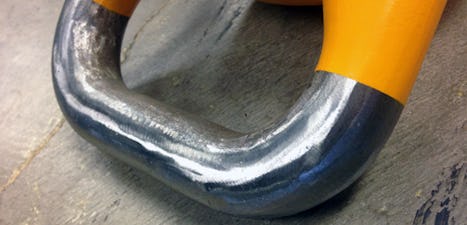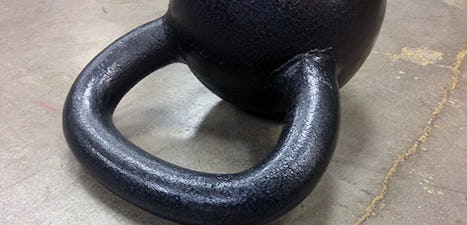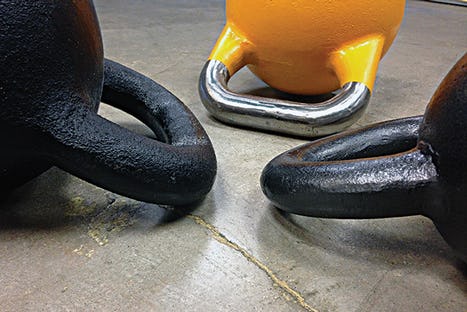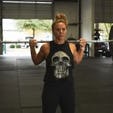Yes, your beat up hands make you FEEL like a badass, but does busting up your skin really MAKE you a badass? Believe it or not, there is an ideal handle smoothness for kettlebells based on your workout objectives. While you can use any kettlebell to get a great workout, comfort level and avoiding injury are vital to your overall success. Use these tips to ensure that you select the right kettlebell handle smoothness for you.
Why is Kettlebell Handle Smoothness Important?
Unlike conventional implements like the barbell or dumbbell, the kettlebell is intended to be used for ballistic type movements like the Clean, Swing, and Snatch. During these movements, the handle of the kettlebell will rotate within your grip, creating friction. During standard sets of 10 to 20 reps, there should be no discomfort from this friction if you’re using proper form. Even so, if you’re doing high repetition sets, challenges, or kettlebell competitions, you’ll be required to perform time-restricted, high-repetition sets. During any of these activities, it is important to consider handle smoothness.
While ignoring the issue and “working through the pain” may earn you some bro-cred, injuring your hands is an excellent way to derail your training. No amount of bro-cred will be worth sacrificing your fitness goals because you had to take time off your training to .
Is Your Kettlebell Handle Too Smooth?
 Some kettlebells featuring an extremely slick surface due to paint, e-coating, or a urethane covering (the handle pictured is of a steel competition kettlebell handle with no coating). While durability is definitely a concern because of the potential for some of these coating to chip, the real concern is the effect it will have on your workout. Unless you are trying to enhance the muscular endurance of your grip, or you really love having chalk floating around everywhere, a kettlebell grip that is too slick will be a pain in the butt and distract from your workout.
Some kettlebells featuring an extremely slick surface due to paint, e-coating, or a urethane covering (the handle pictured is of a steel competition kettlebell handle with no coating). While durability is definitely a concern because of the potential for some of these coating to chip, the real concern is the effect it will have on your workout. Unless you are trying to enhance the muscular endurance of your grip, or you really love having chalk floating around everywhere, a kettlebell grip that is too slick will be a pain in the butt and distract from your workout.
If you find that you are concentrating on holding onto the handle hard enough to keep it from flying out of your hand during the 2-Hand Kettlebell Swing (with a modest weight), the handle may be too slick for you. If your objective is overall strength and conditioning, you should be concentrating on intensity and form, not worrying about killing the person in front of you during your kettlebell class.
Conversely, you may want a slick handle if you’re trying to enhance your grip strength. One challenging workout to enhance grip strength using this concept is to put soap on your hands and perform 100 reps of the 2-Hand Kettlebell Swing. Similar to having extremely sweaty hands, soap on a slick kettlebell handle will force you to squeeze the handle much more than the loose hook grip you would use during a proper kettlebell swing.
Please note that while the picture features the handle of a steel competition kettlebell, and the smoothness of such a kettlebell could be an issue for some people, there is a specific reason for it in this circumstance. Competition kettlebells are designed for high rep sets and must be adaptable for a range of competitors. The “raw” surface (it has no coating at all) is necessary to provide this flexibility. Even so, kettlebell competition is another level of training, and I’m simply addressing the majority of new kettlebell lifters who may be reading this article.
Is Your Kettlebell Handle Too Gritty?
 If you own a cheaply made, old, cast-iron kettlebell that has rusted over due to being left out in the rain, you know what “too gritty” means. Not surprising to anyone, a gritty handle will rip up your hands in no time (even if you have proper form and are performing relatively low-rep sets). If your kettlebell appears extremely bumpy, or if you find a “groove” or line directly under the kettlebell handle, you have made an unfortunate purchase (sorry). While you could try to sand it down, there are other issues that are likely with a poorly made kettlebell, namely the handle diameter and ball/handle dimensions.
If you own a cheaply made, old, cast-iron kettlebell that has rusted over due to being left out in the rain, you know what “too gritty” means. Not surprising to anyone, a gritty handle will rip up your hands in no time (even if you have proper form and are performing relatively low-rep sets). If your kettlebell appears extremely bumpy, or if you find a “groove” or line directly under the kettlebell handle, you have made an unfortunate purchase (sorry). While you could try to sand it down, there are other issues that are likely with a poorly made kettlebell, namely the handle diameter and ball/handle dimensions.
Even with the drawbacks of a handle that is too gritty, your crumby kettlebell can still be useful! While you will probably want to avoid high rep ballistic lifts, you can still perform slow controlled movements without destroying your hands. These include Kettlebell Front Squats, Strict Presses, Floor Presses, Windmills, Lunges, Deadlifts, Pistol Squats, and Halos (basically anything that doesn’t involve transferring the kettlebell from one position to another too much).
Is Your Kettlebell Handle Just Right?
 There are a variety of opinions in what “just right” means in relation to kettlebell handle smoothness. After years of practicing and training others with kettlebells, here is mine. To me, ideal handle smoothness is a careful balance between smoothness and grittiness. As mentioned above, a handle that is too smooth requires a ton of grip strength (forcing you to lower the weight) or chalk (which can be annoying to use in your living room). A handle that is too gritty can damage your hands too easily (have you ever done a workout when your hands are ripped up and bleeding? Not fun.).
There are a variety of opinions in what “just right” means in relation to kettlebell handle smoothness. After years of practicing and training others with kettlebells, here is mine. To me, ideal handle smoothness is a careful balance between smoothness and grittiness. As mentioned above, a handle that is too smooth requires a ton of grip strength (forcing you to lower the weight) or chalk (which can be annoying to use in your living room). A handle that is too gritty can damage your hands too easily (have you ever done a workout when your hands are ripped up and bleeding? Not fun.).
In most cases, people use kettlebells for basic strength and conditioning work, either in a group setting or at home. For this standard situation, a relatively smooth handle with a touch of grittiness is ideal. Imagine it this way: a completely smooth handle that has been lightly sprinkled with sand, then covered in a clear coat (this isn’t how they are made, but it gives you an idea of how ideal handle smoothness should feel). You should be able to do lots of ballistic lifts without having your grip taxed too much while also maintaining the skin on your hands. For high rep work, just a light coat of chalk on your hands should suffice (rather than the cloud of chalk you see some people working with).
Please note that even with ideal kettlebell handle smoothness, you WILL GET CALLUSES. And don’t be a wuss and wear gloves either; kettlebells are intended to provide functional benefits to your daily life, and guess what? You probably won’t be wearing gloves all the time.


)





